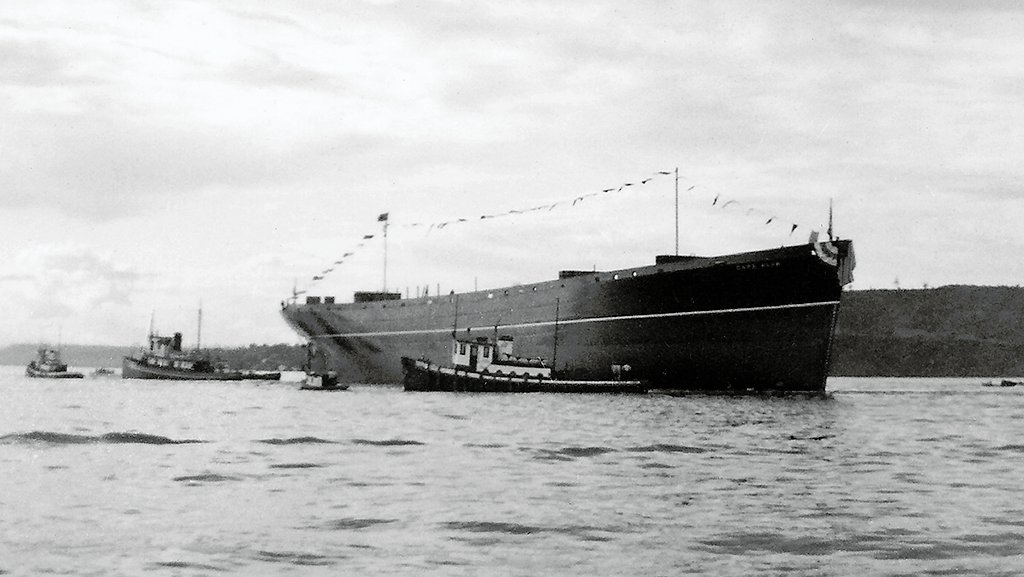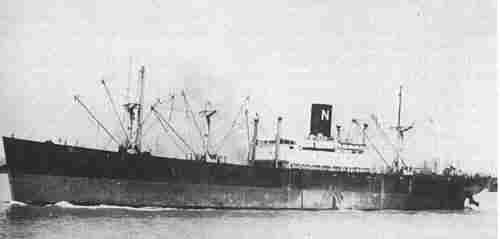On August 3, 1940, the Todd Shipyards Corporation launches the C-1 freighter Cape Alava from the company’s Port of Tacoma shipyard on the Blair Waterway. It is the first ship built at the Todd Tacoma yard since the facility was shuttered in 1925 following a decline in shipbuilding after World War I. Leading up to World War II, demand for shipbuilding increases, and Todd rebuilds and reopens its Tacoma yard in 1940, operated by a subsidiary first named the Seattle-Tacoma Shipbuilding Corporation and then Todd-Pacific Shipyards Inc. Over the next six years, Todd’s Tacoma yard employs 33,000 men and women and builds scores of ships, the vast majority for the war effort. But in a repeat of Todd’s 1920s experience, the company’s shipbuilding prospects shrink following the war. The company ends its Port of Tacoma operations for good in 1946, swapping its shipyard to the U.S. Navy for land adjacent to the company’s Seattle ship-repair plant on Harbor Island.
World War I Creates a Shipbuilder
Todd Shipyards Corporation was founded in 1916 by William H. Todd (1864-1932) and a group of more than 100 colleagues, who together bought New York’s largest ship-repair facility — the Erie Basin yard — on New York Harbor. West Coast expansion came in the same year, when Todd Shipyards bought Seattle Construction and Dry Dock Company, a “pioneer in iron and steel shipbuilding” (Mitchell, 18). The Seattle company had been founded by industrialist Robert Moran (1857-1943), who was twice elected mayor of Seattle.
Moran’s shipyard was known for building submarines and the battleship USS Nebraska, launched October 7, 1904, but William Todd later stressed that when he bought the company, the focus was to be repair, not shipbuilding: “It was realized … that there was no real money to be made in ship construction, especially upon the West Coast … [None] of the directors of Todd Shipyards Corporation ever intended to embark upon the ship construction business” (Mitchell, 30).
The intention may have been repair, but Todd Shipyards had inherited orders for new ships from Seattle Construction and Dry Dock — more than 12 ships slated to be built — and the lead-up to World War I made shipbuilding a priority in Todd’s West Coast shipyards.
Todd Expands to Tacoma … Then Contracts
Todd Shipyards Corporation found itself in need of more space in 1916, only six months after coming into existence. There was no room in Seattle — Todd’s shipyard was bordered by land owned by other companies. Todd found what it needed on Commencement Bay in Tacoma, on what would later be the Port of Tacoma’s Blair Waterway (voters created the public port in 1918).
The Seattle yard built a 12,000-ton dry dock that was then floated to Tacoma, to what even then William Todd conceived of as “a small construction business … as a feeder for a repair business” (Mitchell, 39). During World War I, however, Todd’s Tacoma shipyard was assigned to build 34 ships by the U.S. government’s Emergency Fleet Corporation — 12 of which ended up being canceled, and the remainder of which were finished during and after the war. These included the USS Omaha and Milwaukee, launched in 1920 and 1921 respectively.
Todd’s Tacoma operations wound down slowly as the company completed the ships it had under contract, ending with two commercial steamships before the Tacoma yard was mothballed in 1925. For nearly the next 15 years, the only activity in the shipyard came in 1933 when Todd razed all but one small building to save on taxes during the Depression.
Tacoma Resurrection

In 1939, fearing war, the U.S. government once again turned its attention to shipbuilding. The U.S. Maritime Commission set a goal of building 500 ships in 10 years for the U.S. merchant marine — the country’s fleet of commercial ships — and later, the government contracted for warships.
Todd Shipyards Corporation resurrected its Tacoma yard for the effort, creating the Seattle-Tacoma Shipbuilding Corporation on July 7, 1939, which would include facilities at both the Ports of Seattle and Tacoma; the Tacoma arm was located on the Blair Waterway, site of the old Todd facility. The new Todd subsidiary was 50 percent owned by a group of businessmen that included Henry J. Kaiser (1882-1967), builder of the Hoover and Grand Coulee dams.
News that the Tacoma shipyard yard would become active again circulated, and scores of unemployed men crowded into the south-sound city in the fall of 1939 as the yard itself was under construction. But a representative from the local metal trades council told Tacoma’s labor newspaper that “we have more men now than can take care of all the work that will be available in the shipyard” (“Workless Men,” 1).
Even as the shipyard neared completion, in February 1940 the same newspaper reported that “not more than 400 men will be employed in the yard at the height of its activity … Those who believe that the establishment of a shipyard in Tacoma [will] parallel in employment the old Todd shipyard days are in for a very rude awakening” (“Shipyard Begins Work”).
The very opposite would prove true.

World War II
Only five months after Todd’s Port of Tacoma yard was up and running, the new facility launched Hull No. 1, the Cape Alava, on August 3, 1940. It was the first C-1 freighter keel laid by the rebuilt shipyard, and the vessel was assigned to the American Mail Line shipping company. Hundreds were on hand to see the vessel launched, celebrating “the rebuilding in the Northwest [of] an industry so essential to capital and payroll, to the furtherance of recapturing the trade of the seven seas and maintaining the strength of our political national defense” (Brintnall, 3).
According to historian C. Bradford Mitchell, Todd’s resurrected Tacoma yard followed the layout of the old facility, “which had been especially advanced for its time in respect to fabrication and straight-line movement of material and assemblies from fabrication shop to assembly areas to vessels on the ways” (Mitchell, 122). But, continues Mitchell, “the ingenious and effective but cumbersome overhead cableways — two miles of them — which had shifted heavy units along this ‘production line’ in 1918, were replaced by giant cranes perfected for shipyard use in the interval. It has been claimed that this yard served as a general prototype for the shipbuilding plants subsequently erected during the [World War II] emergency” (Mitchell, 123).
By the time the United States entered the war in 1941, shipbuilding had reached a frenzied pitch. Todd’s Seattle-Tacoma Shipbuilding Corporation — rechristened Todd-Pacific Shipyards Inc. in 1944 — built scores of ships for the war effort between its Seattle and Tacoma plants. The Tacoma yard employed 33,000 men and women — far exceeding the 400 anticipated — and turned out five freighters, two transports, 37 escort carriers, five gasoline tankers, and three destroyer tenders.
The Dust Settles
After the war, shipbuilding demand predictably declined, and Todd sought to return to its roots in ship repair, echoing William Todd’s original vision.
In July 1946, the Tacoma branch of the Todd-Pacific Shipyards subsidiary launched its last ships — the destroyer tender Isla Royale, destroyer Eversole, and escort carrier Tinian. By that time, John D. Reilly (1888-1971), successor to William Todd as president of the overall Todd Shipyards Corporation, was planning for postwar consolidation — he was negotiating with the U.S. Navy to trade Todd’s Tacoma facility for the navy’s former destroyer shipyard in Seattle, which neighbored Todd’s ship repair operation.
Todd-Pacific Shipyards was liquidated as a legal entity on November 29, 1946, and Todd shipbuilding in Tacoma came to an end. “Todd Pacific” would resurface as the name of the overall Todd corporation in 1990, after the company downsized from its national and international operations to just its Seattle shipyard.
This essay made possible by:
Port of Tacoma
Sources:
B. W. Brintnall, “Hundreds See Ship Launched,” Tacoma News Tribune, pp. 1, 3; HistoryLink.org Online Encyclopedia of Washington State History, “Port of Tacoma — Thumbnail History, Part 2” (by Kit Oldham), http://www.historylink.org (accessed August 7, 2008); HistoryLink.org Online Encyclopedia of Washington State History, “World War II Home Front on Puget Sound” (by James R. Warren), http://www.historylink.org (accessed August 7, 2008); C. Bradford Mitchell, Every Kind of Shipwork: A History of Todd Shipyards Corporation, 1916-1981 (New York: Todd Shipyards Corporation, 1981); “Our New Name,” Todd-Pacific Keel, June 1944, p. 1; “Shipyard Begins Work in Lofts,” Tacoma Labor Advocate, February 2, 1940, p. 1; “Tacoma Launches a Ship,” Ibid., August 13, 1940, p. 38; “The Todd Story,” Todd Pacific Shipyards Corporation website accessed August 7, 2008 (http://www.toddpacific.com/company/todd_story.php); “Workless Men Crowd Tacoma,” Tacoma Labor Advocate, September 29, 1939, pp. 1, 3.
Reprinted from historylink.org
Cover photo from armed-guard.com

